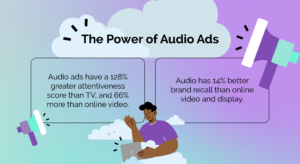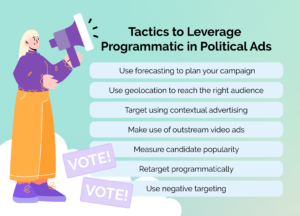Political advertising is poised for unprecedented growth in the upcoming year. Ad spending is set to surpass $10 billion, breaking records in the 2024 election cycle. However, blowing up your ad spend without insight into what channels to cover, what audience to go for, and how to leverage programmatic is not the way.
Allocating advertising budgets strategically and creating standout ads are more critical than ever. Explore what makes a good political ad, focusing on the best practices for political advertising to help you create relevant and effective campaigns.
The Top 5 Creative Formats for Digital Political Ads
The adage “Don’t put all your eggs in one basket” has never been more relevant in political advertising. To make a real impact as a political marketer, you must develop a cross-channel strategy. Your strategy should not only diversify advertising platforms but also enable your messaging to rise above the noise.
Here are five digital channels that can improve the effectiveness of your political ads and significantly impact voter turnout:
CTV
Going into 2024, overexposure to TV advertising is a thing of the past — television advertising still plays a pivotal role in political campaigns. However, the rules of the game have evolved, and the emergence of connected TV (CTV) has breathed new life into political marketing.
Historically, political advertisers heavily relied on linear TV advertising
to reach the masses. The focus was on securing prime airtime, particularly during
peak viewing hours, and delivering messages to potential voters within designated market areas (DMAs). Gross Rating Points (GRPs) were the name of the game.
Now, CTV has disrupted the conventional landscape, offering a new
and compelling approach to political advertising. Notably, CTV provides incremental reach, addressing a key challenge faced by linear TV — the inability to connect with a substantial portion of voters who do not subscribe to traditional television services. CTV:
- Merges the best elements of traditional linear TV with the precision of digital advertising. It retains the familiarity of TV while embracing the advantages of targeted digital advertising.
- Enables data-driven fine-tuning and precise 1:1 voter targeting. Leveraging information such as past voting records, specific geographical locations, and individual interests, political marketers can create tailored campaigns that resonate with specific demographics, thereby enhancing the effectiveness of their political outreach strategies.
- Leverages Automatic Content Recognition (ACR) data, which provides invaluable insights into viewer behavior and preferences. ACR is a technology that is used to identify the content being displayed on a viewer’s screen. With ACR data, political marketers can serve ads strategically. This includes targeting voters who have been exposed to ads from other candidates.
- Offers specific and customizable audience buys, allowing marketers to engage directly with the viewers most likely to resonate with their messaging.
In 2022, CTV emerged as a dominant force in political advertising. It was forecast to account for around 16.67% of all advertising spend, equivalent to $1.5 billion, per AdImpact’s research. This impressive figure underscores its effectiveness in reaching and persuading voters.

Interactive Display Ads
Interactive display ads, including in-banner video, offer a unique opportunity to engage with voters on a deeper level. They serve as a bridge between initial awareness and the decision-making phase, fostering recognition, trust, and a positive reputation. These dynamic ads also shape voter perception by reinforcing messaging, encouraging engagement, and driving action with strong CTAs.
Moreover, the interactive nature of interactive display ads provides valuable insights into audience preferences and concerns. For example, you can gain invaluable insights into your audience’s preferences and opinions regarding political candidates using interactive polls and surveys. These insights go beyond basic demographic data, offering a deeper understanding of what truly matters to voters. With this knowledge, you can fine-tune your campaign to resonate with voters’ needs and concerns.
Native Ads
These unassuming ads are created in such a way that they don’t disrupt the user experience; instead, they harmonize with the platform’s look and feel, almost becoming a part of it. This seamless integration into the User Interface (UI) is a strategic advantage, as it ensures that voters engage with the content organically without feeling like they are being subjected to overt advertising. This can help foster a sense of credibility and trust.
Strong native ads for political campaigns possess a winning formula: clear messaging, engaging copy, and eye-catching visuals. This combination entices voters to click and explore, leading them to educational materials that can influence their decisions on election day.
In 2012, Obama for America (OFA) became the first political campaign to advertise on BuzzFeed. By creating content that was native to BuzzFeed’s format and audience, the OFA campaign reached a large number of potential voters in a way that was both engaging and effective. For instance, the “4 Ways President Obama Will Strengthen The Middle Class” video garnered over one million views.

Video Ads
Video ads have become a cornerstone of political advertising, offering a unique blend of emotional connection, reach, and impact.
- Video ads excel at evoking emotions and establishing a deep connection with the audience. This is because the art of storytelling thrives in video ads. Through narratives and visuals, political campaigns can craft compelling stories that engage voters and inspire action.
- Programmatic video ads offer an additional layer of sophistication. They allow campaigns to target specific demographics, ensuring the right message reaches the right audience. Political advertisers can maximize their impact by utilizing programmatic video while maintaining cost efficiency.
During the 2021-2022 election cycle, the political video ad market was projected to reach $8.8 billion, up from $3.9 billion during the 2017-2018 cycle. That’s some significant market value you can’t ignore.
Audio Ads
Audio ads are emerging as a powerful and cost-effective tool in political advertising, and for good reason. According to an audio ad study by Dentsu:
- Audio ads have a 128% greater attentiveness score than TV and a 66% greater score than online video.
- Audio generates 14% higher brand recall than online video and display.

Marketers can also include a companion banner to digital audio ads, thus extending their effectiveness. A companion banner provides voters with the opportunity to click and engage further. This enhances the interactive potential of the campaign and encouraging deeper involvement with the political messaging.
Furthermore, digital audio ads stand out from traditional radio through precise 1:1 targeting. This is achieved through leveraging parameters such as past voter records, browsing history, geographical location, and preferred news providers.
As marketers become more acquainted with the potential of digital audio, it will likely become a more influential medium in political advertising. Its ability to engage listeners on a deeper level and create lasting impressions in a cost-effective manner makes digital audio a promising avenue for reaching and persuading voters.
Benefits of Programmatic in Political Ads
With a staggering 13 million ad impressions available every second, the unparalleled scale of programmatic ensures that political messages can effectively and efficiently reach a vast audience. Programmatic advertising offers several other benefits that make it an indispensable tool for political campaigns:
Speedy Campaign Adjustments
Programmatic advertising excels in this regard, enabling quick campaign adjustments and real-time optimizations. Campaign managers can adapt to shifting dynamics and respond promptly to emerging trends or issues. This agility ensures that political campaigns remain relevant and responsive to voters’ ever-evolving needs and concerns.
Extended Reach
Programmatic advertising extends the reach of political ads to a broader and more diverse audience. By leveraging data and algorithms, campaigns can identify and target potential supporters across various digital platforms.
This expanded reach goes beyond traditional boundaries, such as television and radio, enabling campaigns to connect with voters who may have otherwise been challenging to engage with through conventional methods.
Precision in Targeting
One of the most remarkable advantages of programmatic advertising lies in its targeting precision. Using various parameters, including exact geographical location, previous voting records, browsing history, preferred news providers, and interests, you can define and segment your audience accurately, ensuring the right message reaches the right people.
This level of granularity allows for personalized, issue-specific messaging that resonates with voters on a personal level, fostering a sense of connection and understanding.
Data-Driven Decision-Making
Programmatic advertising provides detailed reporting that offers valuable insights into the effectiveness of campaigns. These insights go beyond vanity metrics, delving into engagement, conversion rates, and other crucial data points.
Armed with this data, you can make data-driven decisions, optimize your strategies, and allocate resources where they will have the most impact.
Tactics to Leverage Programmatic in Political Ads
To get the most out of your programmatic political ads, consider using the following tactics to improve the effectiveness of your campaigns:

- Use forecasting to plan your campaign: Analyze data and trends to help predict audience behavior, identify key opportunities, and strategize your ad campaigns accordingly. This forward-thinking approach ensures that your political ads are timely and resonate with the electorate’s current interests and concerns.
- Use geolocation to reach the right audience: Pinpoint your ads to specific geographic regions or even target micro-locations within a given area using geolocation. Using this precise geotargeting is particularly useful for localized political campaigns and election efforts. Compared to traditional channels, geolocation minimizes waste by ensuring your message only reaches voters in the specific districts you are targeting.
- Target using contextual advertising: Contextual advertising involves placing ads in environments that are thematically relevant to the content. In political advertising, this tactic allows campaigns to align their messages with contextually appropriate digital spaces. By ensuring that political ads appear alongside content that complements their messaging, marketers can enhance the relevance and resonance of their advertisements.
- Use outstream video ads: Outstream video ads don’t rely on pre-existing video content but can appear within articles, making them non-intrusive and effective. They provide an opportunity to reach audiences on platforms where traditional video ads might not be suitable. This expands your campaign’s digital footprint.
- Measure candidate popularity: Understanding a candidate’s popularity is paramount for any political campaign. With programmatic advertising, you can collect data on candidate popularity in real time. This allows you to adapt your strategies and focus resources and messaging on candidates who resonate most with voters.
- Retarget programmatically: Retargeting allows you to re-engage with potential supporters who have interacted with your content but have yet to take the desired action, such as making a donation or signing up for updates. This tactic keeps campaigns in voters’ minds, nurturing their engagement and increasing the likelihood of conversion.
- Use negative targeting: An often-underutilized tactic, negative targeting involves excluding specific demographics or audiences — based on factors such as political affiliation — from seeing your ads. For political campaigns, this can be crucial in avoiding ad fatigue. Additionally, it ensures that you direct resources toward receptive audiences, preventing ads from reaching unintended targets.
How To Get Started with Programmatic Political Advertising
To achieve a positive ROAS with programmatic advertising, having a well-thought-out strategy and effective political ads is essential.
At Grapeseed Media, we ensure our campaigns are based on extensive experience in successfully running hundreds of them nationwide.
To learn more, visit our politics-focused solutions page for a detailed guide on how to get started with programmatic political advertising and make your campaigns a success.

